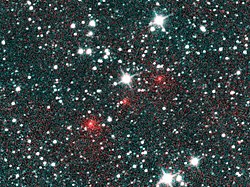C/2020 F3 (NEOWISE)
| C/2020 F3 (NEOWISE) | |
|---|---|
 Snímek komety a hvězdného pozadí z 14. července 2020 | |
| Objeveno | |
| Datum | 27. března 2020 |
| Místo | Wide-field Infrared Survey Explorer |
| Objevitel | Wide-field Infrared Survey Explorer |
| Elementy dráhy (Ekvinokcium J2000,0) | |
| Epocha | 2010-08-03 UTC 2459064,5 JD |
| Velká poloosa | 53 051 437 000 km 354,627 au |
| Výstřednost | 0,999169 ±0,000002 |
| Perihel | 44 079 000 km 0,294651 au |
| Afel | 106 058 000 000 km 709 au |
| Perioda (oběžná doba) | 2 439 000 d (6 678 ±25,6 a) |
| Sklon dráhy | |
| - k ekliptice | 128,94° |
| Délka vzestupného uzlu | 61° |
| Argument šířky perihelu | 37,278° |
| Poslední průchod perihelem | 4. červenec 2020 |
| Příští průchod perihelem | neznámý |
C/2020 F3 (NEOWISE) či kometa NEOWISE[1] je jasná dlouhoperiodická kometa viditelná i pouhým okem během léta 2020. Objevena byla 27. března 2020 infračerveným kosmickým teleskopem Wide-field Infrared Survey Explorer (WISE) v rámci projektu NEOWISE. Přísluním prošla 3. července 2020. Blízký průlet kolem Slunce způsobil změnu parametrů její oběžné dráhy. Velká poloosa se zvětšila z 275 na 355 AU a oběžná doba narostla ze 4 500 na 6 700 let. Sklon její oběžné dráhy k rovině ekliptiky má hodnotu 129°, což značí, že kometa obíhá retrográdně – v opačném směru, než kolem Slunce obíhají planety.[2][3][4]
Slunci se kometa nejvíce přiblížila 3. července 2020 na vzdálenost 0,29 au (43 milionů km v perihéliu), kdy se na obloze nacházela v souhvězdí Velké medvědice.[5][6]
Klasifikace a název
Mezi komety byl objekt zařazen 31. března 2020 a pojmenován po projektu NEOWISE. V systematickém označení C/2020 F3 vyjádřilo „C“ neperiodickou kometu, „F“ druhou polovinu března a „3“ třetí objevenou kometu v tomto období.[7][8][9]
Charakteristika
Průměr jádra komety je odhadován na 5 km. Jak ukázaly snímky ze sluneční sondy Parker Solar Probe, kometa má dva ohony: plynový (plazmový) a prachový. V plynovém ocase byla odhalena mezera, což může být následek toho, že kometa má dva plynové ocasy a tedy tři ocasy celkově.[10]
Galerie
- Pozorování komety NEOWISE ze severozápadu Slovenska
- Složený obrázek tří infračervených záběrů NEOWISE z objevu komety 27. března 2020. Kometa zobrazena jako tři červené body v střední části.
Reference
V tomto článku byl použit překlad textu z článku C/2020 F3 (NEOWISE) na slovenské Wikipedii.
- ↑ On This Day in 2020: Comet NEOWISE. The Earth Observator, NASA [online]. 2023-07-05 [cit. 2023-11-12]. Dostupné online. (anglicky)
- ↑ C/2020 F3 (NEOWISE). JPL Small-Body Database Browser [online]. Jet Propulsion Laboratory [cit. 2020-07-20]. Dostupné online.
- ↑ TICHÝ, Miloš. www.komety.cz [online]. 2020-07-04 [cit. 2020-07-16]. Dostupné online.
- ↑ GEMBEC, Martin. 29. vesmírný týden 2020. astro.cz (Ondřejov: Česká astronomická společnost) [online]. [cit. 2020-07-16]. Dostupné online.
- ↑ ZASTROW, Mark. Comet C/2020 F3 (NEOWISE) springs a naked-eye surprise | Astronomy.com. Astronomy Magazine [online]. 2020-07-06 [cit. 2023-11-12]. Dostupné online. (anglicky)
- ↑ Comet C/2020 F3 NEOWISE. heavens-above.com [online]. [cit. 2020-07-20]. Dostupné online.
- ↑ MPEC 2020-G05 : COMET C/2020 F3 (NEOWISE). Minor Planet Electronic Circulars [online]. 2020-04-01 [cit. 2023-11-12]. Dostupné v archivu pořízeném z originálu dne 2020-07-15. (anglicky)
- ↑ The newly discovered comet NEOWISE has been given the name C/2020 F3. What is the meaning of the F3 and the C in this name?. Astronomy Stack Exchange [online]. 2023-11-12 [cit. 2023-11-12]. Dostupné online. (anglicky)
- ↑ MANN, Adam. Comet NEOWISE: How to See It in Night Skies. The New York Times [online]. 2021-09-30 [cit. 2023-11-12]. Dostupné online. ISSN 0362-4331. (anglicky)
- ↑ MARTINEK, František. Sonda Parker Solar Probe pozorovala kometu NEOWISE. astro.cz (Ondřejov: Česká astronomická společnost) [online]. [cit. 2020-07-16]. Dostupné online.
Externí odkazy
 Obrázky, zvuky či videa k tématu C/2020 F3 (NEOWISE) na Wikimedia Commons
Obrázky, zvuky či videa k tématu C/2020 F3 (NEOWISE) na Wikimedia Commons - C/2020 F3 (NEOWISE) – aktuální poloha na The Sky Live
- C/2020 F3 (NEOWISE) – aktuální poloha na Heavens-Above
- Elementy dráhy a interaktivní model sluneční soustavy s trajektorií komety na webu JPL Small-Body Database NASA
Média použitá na této stránce
Autor: SimgDe, Licence: CC BY-SA 4.0
Image is aligned to stars. Total exposure time was 15 min.
Autor: Palonitor, Licence: CC BY-SA 4.0
Fotografia kométy z Konskej neďaleko Žiliny dňa 15.08.2020.
Comet C/2020 F3 NEOWISE appears as a string of fuzzy red dots in this composite of several heat-sensitive infrared images taken by NASA's Near-Earth Object Wide-field Infrared Survey Explorer (NEOWISE) mission on March 27, 2020. The comet was discovered using these images to track its motion across the sky against the backdrop of stationary stars and galaxies. These images have been processed such that cyan colors represent NEOWISE's 3.4-micron channel (a wavelength of light approximately seven times longer than the green light that humans see), and red colors represent the NEOWISE 4.6-micron channel. The comet's extended halo, or coma, of gas and dust was already apparent in the discovery images. The comet appears much redder than the background stars and galaxies because it is much cooler and therefore emits more light at longer wavelengths.
Sun in the center of the image, C/2020 F3 (NEOWISE) in the upper left.
Autor: Tomruen, Licence: CC BY-SA 4.0
en:C/2020 F3 (NEOWISE) path across sky, stereographic projection, 7 day step-size. The retrograde loops are caused by parallax from Earth's annual motion around the Sun. The size of the yellow circles are symbolic and inversely proportional to distance, as if it was a fixed sized sphere in space. The yellow line represents the ecliptic, the path of the sun across the sky. The most movement occurs when the comet is closet to Earth. When the comet is far from the Sun/Earth the apparent motion is very small. The yellow line passing through the middle is the path of the Sun and the Sun passes Spica every October 16.








